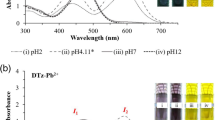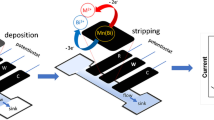Abstract
A paper-based analytical device (PAD) is presented with colorimetric/electrochemical dual readouts for the simultaneous sensing of total chromium (Cr) and hexavalent chromium (Cr(VI)). This device consists of a homemade three-electrode system and a patterned paper chip, integrating multiple functions including electrochemical detection, fluid driving, online oxidation, and colorimetric detection. The fiberglass filter paper with a hydrophilic microchannel was used to achieve self-driving fluidics without external equipment. One end of the microchannel was integrated with a homemade three-electrode system to achieve sample loading and electrochemical detection. The middle region on the microchannel was modified with oxidizing reagents to perform online pretreatment, and the yield of Cr(III) oxidation can reach 97.9%, ensuring reliable colorimetric detection of total Cr at another end of the microchannel modified with chromogenic agents. With this device, the signals of Cr(VI) (the signal peak at 0.29 V vs. Ag/AgCl) and total Cr can be obtained in one single injection. After optimization, the limit of detection (LOD) of Cr(VI) and total Cr were 0.01 mg L−1 and 0.06 mg L−1 and the linear ranges were 0.05–3.0 mg L−1 and 0.2–3.0 mg L−1, respectively. The relative standard deviations (RSD) of the electrochemical testing of Cr(VI) results were in a range 1.3%–8.7% (n = 3), and the RSD values of the colorimetric testing of total Cr were between 0.7–9.2% (n = 3). The device’s reliability was demonstrated by performing the practical speciation of Cr in tap water, river water, and electroplating wastewater while the recoveries obtained using the present method were in the range 93.5–106%. Overall, the proposed device provides high application prospect in the on-site rapid Cr speciation.
Graphical abstract







Similar content being viewed by others
References
Guo SY, Xiao CQ, Zhou N, Chi R (2021) Speciation, toxicity, microbial remediation and phytoremediation of soil chromium contamination. Environ Chem Lett 19:1413–1431. https://doi.org/10.1007/s10311-020-01114-6
Shahid M, Shamshad S, Rafiq M, Khalid S, Bibi I, Niazi NK, Dumat C, Rashid MI (2017) Chromium speciation, bioavailability, uptake, toxicity and detoxification in soil-plant system: a review. Chemosphere 178:513–533. https://doi.org/10.1016/j.chemosphere.2017.03.074
Sedman RM, Beaumont J, McDonald TA, Reynolds S, Krowech G, Howd R (2006) Review of the evidence regarding the carcinogenicity of hexavalent chromium in drinking water. J Environ Sci Health C 24:155–182. https://doi.org/10.1080/10590500600614337
Linos A, Petralias A, Christophi CA (2011) Oral ingestion of hexavalent chromium through drinking water and cancer mortality in an industrial area of Greece-An ecological study. Environ Health 10:50. https://doi.org/10.1186/1476-069X-10-50
A Pechova L Pavlata 2007 Chromium as an essential nutrient: a review Veterinarni Medicina 52 1 18 https://doi.org/10.17221/2010-VETMED
Anderson RA, Cheng N, Bryden NA, Polansky MM, Cheng N, Chi J, Feng J (1997) Elevated intakes of supplemental chromium improve glucose and insulin variables in individuals with type 2 diabetes. Diabetes 46:1786–1791. https://doi.org/10.2337/diab.46.11.1786
Hernández-Ruiz E, Alvarado-Flores J, Rubio-Franchini I, Ventura-Juárez J, Rico-Martínez R (2016) Adverse effects and bioconcentration of chromium in two fresh-water rotifer species. Chemosphere 158:107–115. https://doi.org/10.1016/j.chemosphere.2016.05.067
Chebeir M, Liu HZ (2016) Kinetics and mechanisms of Cr(VI) formation via the oxidation of Cr(III) solid phases by chlorine in drinking water. Environ Sci Technol 50:701–710. https://doi.org/10.1021/acs.est.5b05739
Zhu XY, Deng Y, Li PC, Yuan DX, Ma J (2019) Automated syringe-pump-based flow-batch analysis for spectrophotometric determination of trace hexavalent chromium in water samples. Microchem J 145:1135–1142. https://doi.org/10.1016/j.microc.2018.12.040
N Dawra N Dabas 2022 Advances in spectrophotometric determination of Chromium (III) and Chromium (VI) in water: a review Int J Environ Anal Chem 1–22 https://doi.org/10.1080/03067319.2022.2076224
Rahbar N, Salehnezhad Z, Hatamie A, Babapour A (2018) Graphitic carbon nitride nanosheets as a fluorescent probe for chromium speciation. Microchim Acta 185:1–9. https://doi.org/10.1007/s00604-017-2615-3
Tahmasebi Z, Davarani SSH (2016) Selective and sensitive speciation analysis of Cr (VI) and Cr (III), at sub-μg L-1 levels in water samples by electrothermal atomic absorption spectrometry after electromembrane extraction. Talanta 161:640–646. https://doi.org/10.1016/j.talanta.2016.09.016
Islam A, Ahmad H, Zaidi N, Kumar S (2016) A graphene oxide decorated with triethylenetetramine-modified magnetite for separation of chromium species prior to their sequential speciation and determination via FAAS. Microchim Acta 183:289–296. https://doi.org/10.1007/s00604-015-1641-2
Jia XY, Gong DR, Xu B, Chi QQ, Zhang X (2016) Development of a novel, fast, sensitive method for chromium speciation in wastewater based on an organic polymer as solid phase extraction material combined with HPLC–ICP-MS. Talanta 147:155–161. https://doi.org/10.1016/j.talanta.2015.09.047
Chen SZ, Zhu L, Lu DB, Cheng XL, Zhou XR (2010) Separation and chromium speciation by single-wall carbon nanotubes microcolumn and inductively coupled plasma mass spectrometry. Microchim Acta 169:123–128. https://doi.org/10.1007/s00604-010-0328-y
Noviana E, Ozer T, Carrell CS, Link JS, McMahon C, Jang I, Henry CS (2021) Microfluidic paper-based analytical devices: from design to applications. Chem Rev 121:11835–11885. https://doi.org/10.1021/acs.chemrev.0c01335
Stern CM, Jegede TO, Hulse VA, Elgrishi N (2021) Electrochemical reduction of Cr(VI) in water: lessons learned from fundamental studies and applications. Chem Soc Rev 50:1642–1667. https://doi.org/10.1039/d0cs01165g
Wang W, Bai H, Li HY, Lv Q, Wang ZJ, Zhang Q (2017) Disposable plastic electrode for electrochemical determination of total chromium and hexavalent chromium. J Electroanal Chem 794:148–155. https://doi.org/10.1016/j.jelechem.2017.04.016
Hilali N, Mohammadi H, Amine A, Zine N, Errachid A (2020) Recent advances in electrochemical monitoring of chromium. Sensors 20:5153. https://doi.org/10.3390/s20185153
Metters JP, Kadara RO, Banks CE (2012) Electroanalytical sensing of chromium (III) and (VI) utilising gold screen printed macro electrodes. Analyst 137:896–902. https://doi.org/10.1039/c2an16054d
Alahmad W, Sahragard A, Varanusupakul P (2021) An overview of the recent developments of microfluidic paper-based analytical devices for the detection of chromium species. Microchem J 170:106699. https://doi.org/10.1016/j.microc.2021.106699
Rattanarat P, Dungchai W, Cate DM, Siangproh W, Volckens J, Chailapakul O, Henry CS (2013) A microfluidic paper-based analytical device for rapid quantify-cation of particulate chromium. Anal Chim Acta 800:50–55. https://doi.org/10.1016/j.aca.2013.09.008
Zhai HM, Zhou T, Fang F, Wu ZY (2020) Colorimetric speciation of Cr on paper-based analytical devices based on field amplified stacking. Talanta 210:120635. https://doi.org/10.1016/j.talanta.2019.120635
Alahmad W, Varanusupakul P, Kaneta T, Varanusupakul P (2019) Chromium speciation using paper-based analytical devices by direct determination and with electromembrane microextraction. Anal Chim Acta 1085:98–106. https://doi.org/10.1016/j.aca.2019.08.002
Muhammed A, Hussen A, Kaneta T (2021) Speciation of chromium in water sam-ples using microfluidic paper-based analytical devices with online oxidation of tri-valent chromium. Anal Bioanal Chem 413:3339–3347. https://doi.org/10.1007/s00216-021-03274-y
Wang W, Ding SN, Wang ZJ, Lv Q, Zhang Q (2021) Electrochemical paper-based microfluidic device for on-line isolation of proteins and direct detection of lead in urine. Biosens Bioelectron 187:113310. https://doi.org/10.1016/j.bios.2021.113310
Danilov FI, Protsenko VS (1998) Electroreduction of hexavalent chromium compounds. Russ J Electrochem 34:276–281
Jin W, Wu GS, Chen AC (2014) Sensitive and selective electrochemical detection of chromium (VI) based on gold nanoparticle-decorated titania nanotube arrays. Analyst 139:235–241. https://doi.org/10.1039/c3an01614e
Wang W, Bai H, Li HY, Lv Q, Zhang Q, Bao N (2016) Carbon tape coated with gold film as stickers for bulk fabrication of disposable gold electrodes to detect Cr (VI). Sens Actuators, B Chem 236:218–225. https://doi.org/10.1016/j.snb.2016.05.155
Kachoosangi RT, Compton RG (2013) Voltammetric determination of Chromium(VI) using a gold film modified carbon composite electrode. Sens Actuators, B Chem 178:555–562. https://doi.org/10.1016/j.snb.2012.12.122
Welch CM, Nekrassova O, Compton RG (2005) Reduction of hexavalent chromium at solid electrodes in acidic media: reaction mechanism and analytical applications. Talanta 65:74–80. https://doi.org/10.1016/j.talanta.2004.05.017
Nair V, Deepthi A (2007) Cerium (IV) ammonium nitrate a versatile single-electron oxidant. Chem Rev 107:1862–1891. https://doi.org/10.1021/cr068408n
Funding
This work was supported by the Beijing Outstanding Young Scientist Program (BJJWZYJH01201910005017) and the National Natural Science Foundation of China (No. 21936001).
Author information
Authors and Affiliations
Corresponding authors
Ethics declarations
Conflict of interest
The authors declare no competing interests.
Additional information
Publisher's note
Springer Nature remains neutral with regard to jurisdictional claims in published maps and institutional affiliations.
Supplementary Information
Additional file 1: Fig. S1 Reaction of Cr (VI) with DPC to form Cr(III)-DPCO complex [7]. Fig. S2 (a) Effect of Ce (IV) oxidizerconcentration on the colorimetric intensity of the Cr-DPCO complex (n=3). (b) Effect of DPC concentration on the colorimetric intensity of the resulting complex (n=3). Sample: 2.0 mg L-1 Cr (III) in 0.01 M HCl. Insets display the corresponding photos. Fig. S3 Storage stability of the gold-coated PET electrodes (n = 3) for detection of the 1.0 mg L-1 Cr(VI). Table S1 Analytical performance of electrochemical and colorimetric methods for chromium speciation. Table S2 Determination of Cr (VI) and total Cr in real samples (n=3)
Rights and permissions
Springer Nature or its licensor (e.g. a society or other partner) holds exclusive rights to this article under a publishing agreement with the author(s) or other rightsholder(s); author self-archiving of the accepted manuscript version of this article is solely governed by the terms of such publishing agreement and applicable law.
About this article
Cite this article
An, Y., Wang, W., Lv, Q. et al. A dual-readout paper-based analytical device for the simultaneous determination of hexavalent Cr and total Cr. Microchim Acta 189, 445 (2022). https://doi.org/10.1007/s00604-022-05532-x
Received:
Accepted:
Published:
DOI: https://doi.org/10.1007/s00604-022-05532-x




